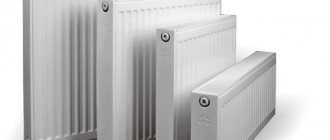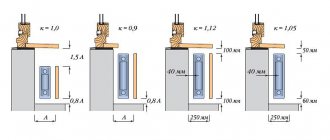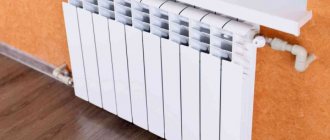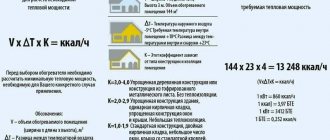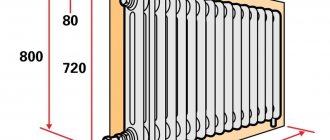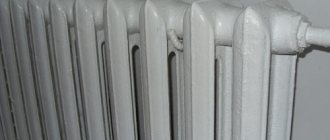Features of central heating and requirements for radiators
A centralized heat supply system has some differences from an autonomous one, which are important to remember when choosing:
- the water entering the pipes is far from ideal: it contains various additives, salts, oxygen and rust;
- hydraulic shocks occur in the system - a sharp increase in pressure, often this occurs during the period when heating is turned on/off and during pressure testing;
- The temperature is also unstable - the batteries either barely warm or burn.
Based on these data, we can formulate an expanded list of required properties of thermal appliances:
- Radiators must withstand pressure 1.5 times higher than what happens in the system. In Soviet panel or brick five-story buildings it is 5–8 atmospheres, in new buildings 12–15.
- The metal must be resistant to corrosion or have a special coating on the inside so that no rust, scale or other troubles linger on the surface. It is good if the material does not react to the presence or absence of water in the system and to changes in temperature in the coolant.
- The thickness of the walls must be sufficient so that abrasive particles (such as rust or sand) do not thin them over time due to friction. Otherwise, a breakthrough cannot be avoided.
- High heat transfer will allow you to get your portion without losses due to poor conductivity.
- In addition to the functional load, this element also has an aesthetic one, so it is desirable that it harmoniously complement the decor and not spoil it.
Which heating radiator to choose
The design also plays an important role, since from time to time it is subject to water hammer. This means that there is a high risk of leaks in weak areas, which are always joints. For this reason, panel structures last longer. When you need to select a radiator, the thickness of the metal is also taken into account, since small debris often circulates in the system. It is better to choose a heating battery with average characteristics if there is no reliable information about the quality of the coolant and the parameters of the boiler equipment.
For apartment
Disadvantages of central heating:
- risk of water hammer,
- the presence of sludge in communications, which penetrates the system along with the coolant, which leads to thinning of the metal from the inside,
- temperature instability.
You can decide which batteries are best to install in an apartment, taking into account the following parameters:
- The nominal pressure must be higher than the working, test pressure. This reduces the likelihood of deformation and, as a result, radiator failure. Standard pressure indicators for 5-story buildings: from 5 to 8 atm. In multi-storey buildings, the coolant pressure is set within 12-15 atm.
- Radiator wear resistance. Thanks to its resistance to negative external factors, the service life of the device is extended.
- The thickness of the battery walls must be significant, which will avoid metal abrasion under regular exposure to internal sludge.
- To prevent the radiator in your home from collapsing due to constant contact with coolant containing chemically active elements, it is recommended to choose products with a protective coating on the inner walls. This problem can also be solved by using a chemically neutral material in the manufacture of internal structural elements.
Taking into account the above parameters, steel radiators are less suitable for arranging a heating system in an apartment. This is due to the fact that such products do not withstand pressure limits. Despite the high thermal conductivity, aluminum analogues are also not suitable for apartment buildings. The fact is that they are deformed under the influence of water hammer.
In addition, aluminum radiators are characterized by mediocre properties: they do not withstand the destructive effects of chemical compounds present in the coolant and are deformed under the influence of extreme pressure values. Bimetallic analogues are strong, durable, can withstand high temperatures, and are less susceptible to corrosion and chemical reagents. However, the cost of such products is high.
https://youtube.com/watch?v=Ur_SpsKOPso
Cast iron batteries are also suitable for the heating system of an apartment building. This is due to the large thickness of the metal, resistance to corrosion, high thermal inertia and thermal conductivity. In addition, in terms of external characteristics, such radiators are not inferior to their analogues.
For a private home
Autonomous heating system parameters:
- low pressure,
- there are no intense water hammers.
If you control the quality of the coolant, you can use different types of batteries to heat your home. For this reason, the main criterion when purchasing is the thermal conductivity indicator, as well as the price-quality ratio of the product. The advantages of various types of radiators in relation to private housing:
- Steel panel batteries. Thanks to their large dimensions (width, height), they cover a wide window opening in private homes. They have sufficient thermal conductivity.
- Tubular steel batteries are similar in parameters to their panel counterparts, but they are distinguished by an attractive appearance and a higher price. Steel appliances require regular maintenance. They are washed every 3 years. In addition, it is advisable to keep such products in a filled state, which will avoid rusting of the metal.
- Aluminum radiators are often chosen for your home. They are distinguished by their compactness, average pressure ratings, and high efficiency of the heat transfer process. However, you will have to constantly monitor the acidity level of the coolant.
- Bimetallic batteries are suitable in all respects for private homes too. Considering that it is necessary to install a large number of radiators in your home, costs will increase significantly, since the cost of bimetallic devices is quite high.
- Cast iron batteries are also suitable for private housing. Their main advantage is their inertia, which allows them to reduce gas costs.
Types of radiators
The properties of the equipment and its ability to withstand negative phenomena depend primarily on the type of material.
Cast iron
A Soviet classic, familiar to every resident of high-rise buildings, because they were everywhere. They often meet even now. Bulky structures that have to be painted regularly to maintain a decent appearance.
And yet, many homeowners are in no hurry to part with old cast iron products for central heating and buy new models that are on the market. Before revealing the secret of such popularity, let's name their disadvantages:
- heaviness - it will take a lot of effort to bring in such a colossus. In addition, it is unlikely that you will be able to install it yourself;
- cast iron is fragile, which is why it does not always withstand strong water hammer;
- high price.
As you can see, there are not many disadvantages. But the advantages of cast iron samples are presented in abundance:
- serve up to 50 years;
- copes well with pressure up to 12 atmospheres (which is often more than enough);
- keep warm for a long time;
- please with efficient heat transfer;
- almost do not rust.
Such devices today are produced not only in the usual design. There are simply stunningly beautiful specimens that fit perfectly into the retro style, as well as quite modern, laconic forms.
To prevent the surface from having to be repainted regularly, a protective paint is applied to it, which does not have to be renewed.
Steel
They look beautiful and are inexpensive. Another positive aspect is the low weight and productive heat output. There are panel and tubular steel radiators.
Panel specimens look like two plates, between which water passes in steel contours. They fit perfectly into the interior as they look very presentable.
Tubular ones consist of several parts welded together and are similar to classic batteries (though their shapes are much more varied). As a rule, they are more expensive than panel ones.
Everything would be fine, but this option is not suitable for an apartment: such products can withstand no more than 10 atmospheres, and if this value is exceeded, they can burst and leak. In addition, without filling with liquid, they often begin to rust.
Aluminum
Light weight and reasonable price. This is the main reason for buying aluminum items. They have a better heat transfer coefficient and can last from 15 to 25 years, but only under conditions of constant low pressure and good quality media. But, as we remember, a centralized system cannot satisfy these requests.
They cannot withstand high pressure and leak. Such structures are also sensitive to water quality and are destroyed by a chemical reaction with the release of oxygen. So, alas, it is better for residents of high-rise buildings to refuse them.
Bimetallic
Consists of an aluminum casing and an internal part made of steel or copper. They can easily withstand temperatures up to 130 degrees and pressures up to 30 atmospheres.
The enamel coating provides an aesthetic appearance: such a device will easily fit into any environment. They are also treated inside and outside with anti-corrosion agents, which keeps them intact for a long time.
There are two types of such radiators.
- Sectional – you can add or reduce the number of segments.
- Monolithic - capable of withstanding pressure up to 100 atm, and therefore are characterized by a large margin of safety.
It is this type that is recommended to be chosen for an apartment building, as it is the most reliable. But the cost of such models is higher than others.
Copper
A rare guest in our stores. This is explained by the high cost of the metal. Although in operation they show themselves to be quite acceptable:
- quickly heat the room, thanks to increased efficiency;
- are not afraid of water hammer up to 25 atmospheres;
- resistant to high coolant temperatures;
- do not need painting or processing;
- do not rust and serve for a long time.
Among the weaknesses, additional requirements for the materials of supply lines and connecting elements can be noted: they must be made of copper or brass. Otherwise, the copper will react with other metal, leading to corrosion and destruction.
However, the design of such items is still quite specific and they cannot fit into any interior, which is clearly visible in the photo.
Cast iron radiators for apartments
Such heating devices are familiar to everyone, since residential buildings in the Soviet years used bulky batteries, for the production of which cast iron was used.
Now heavy heating units are becoming a thing of the past, giving way to modern and at the same time powerful, efficient and stylish analogues. Cast iron as a material has excellent thermal conductivity, heats up for a long time and also cools down for a long time. It is durable and reliable, able to withstand operating pressures reaching 25 - 30 atmospheres.
Cast iron units are not at risk of water hammer, they are universal and can function with pipes made of different materials. If you purchase heating appliances for an apartment made of cast iron, you will not need to replace the entire pipeline.
After prolonged contact with the coolant from inside the radiator, a black precipitate gradually accumulates on its walls, which forms a film that prevents oxygen from penetrating the manufacturing material.
Provided that operating standards are met, cast iron batteries rarely fail as a result of metal destruction. Modern appliances are coated on the outside with a special protective paint. Therefore, there is no need to paint them often. Thanks to their smooth surface, almost no dust collects on them and no gases form inside. There is no need to constantly bleed air from cast iron radiators in order to remove air pockets.
Modern analogues differ in appearance and size. This circumstance significantly helps to solve the problem of how to choose a cast-iron battery to ensure comfortable living in the room and taking into account the design of the room. Thus, products from foreign manufacturers, designed in retro style, are decorated with ornaments and castings.
The cast iron heating structure can be expanded depending on the size of the room. The number of sections that need to be selected depends on a number of parameters:
- number of windows and doorways;
- square footage of the room;
- climate features.
In domestic batteries, the filling volume is 1.3 liters, and in foreign ones - 0.8 liters. Products from such imported manufacturers have an optimal balance between price and quality: Guratec, Demir Docum, Konner, Roca and others (read: “What is good about the Konner cast iron radiator - the advantages and rules for installing the Konner heating battery”). Russian and Belarusian products of the MS-140 and BZ-140 series have proven themselves well.
Previously, strong brackets were hammered into the wall to secure cast iron radiators, but today, for stylish heating devices, manufacturers provide floor mounting.
Advantages of cast iron heating radiators:
- affordable price;
- strength and reliability;
- compatibility with pipes made of various materials;
- easy and long-term operation;
- absence of corrosion processes;
- minor requirements for water quality.
The disadvantages of these heating devices include:
- Heavy weight, which seriously complicates installation.
- To fix it on the wall, you need to use bulky brackets, which may not fit into the style of the room.
- Not all cast iron products correspond to modern apartment design.
- Since cast iron has poor inertia, it cools slowly, which is not always an advantage, since it is not always possible to quickly adjust the optimal temperature in the room.
In a private house where autonomous heating is installed, the operation of such batteries is expensive. That is why their owners are so interested in the question of how to choose the right heating radiator for their home, taking into account its technical characteristics.
Power and dimensions
We have decided on the material, now it’s time to calculate the number of sections and dimensions of the device that is most suitable for us. In a good way, many room parameters are taken into account here:
- square;
- ceiling height;
- wall thickness;
- the number of windows and how they are glazed;
- presence of a balcony;
- location: corner or in the middle of the building, first, last or middle floor.
In addition, it is important to take into account the climatic features of your region and personal preferences: do you like it when your home is cool or, conversely, hot.
There is even a special calculator that, using a complex formula, will select the required power, taking into account the entered parameters.
Simplified, this formula looks like this:
N = S x 100 / Pc,
where N is the number of sections,
S – room area in square meters. m.,
Pc – power of one segment of the model you have chosen (indicated in the product passport)
There is an option where the ceiling height (h) is also taken into account:
N = S xhx 41 (34) / Pc.
Separately, it should be explained what the numbers 41 and 34 are, and which one should be used in your calculations. This is the power of the heating system per 1 sq. m. room, which is:
- 41 W in panel houses;
- 34 W in brick.
As for the height of the battery, it all depends on the place where you install it: if under a window, then you need to measure the distance from the top edge of the battery to the window sill, and from the bottom to the floor. There should be at least 10 cm of free space on each side. This is necessary to ensure proper convection. There are two standard values: 35 and 50 cm, so choose the one that best matches the dimensions of your apartment.
The depth also varies from 7 to 10 cm, so if you are limited in space, you can always take equipment of greater depth and thus increase its efficiency.
It is also important to know that placing it in a deep niche or installing a screen in front of the radiator leads to a decrease in heat transfer efficiency. In this case, it is advisable to increase the power of the installed device.
Approximately the number of parts can be calculated as follows: for every 1.5 - 2 sq. m. there is one section or 100 W.
There are devices that can be expanded by adding additional elements after installation. If you suddenly freeze in winter, you can buy a couple more parts and build them up.
For those cases where it is not possible to expand sections, you will have to buy an electric room heater to create a comfortable environment.
Which radiators heat better, what is their real heat output?
Radiators at home do not provide the power that is specified in the documentation. To find out the real heat transfer from the radiator you need a small calculation. Power data on the shelves advertises the product rather than informs us. We can count on more modest heat transfer; let’s look at how to determine the real power of different radiators.
What does the power of radiators indicated in the documentation mean?
The power of the radiator will directly depend on their temperature. The larger it is, and the colder the room, the more heat will be given off. But how much is it really?
By opening the passport supplied with the radiator, you can find out that one section of the radiator has a thermal power of, for example, 180 W. But with a small caveat - at “Δt = 50 degrees”. What is this?
The designation in the documentation Δt, or dt, or DT, or “Temperature Difference” is the difference between the average temperature of the radiator and the air temperature in the room. For example, 60 degrees, minus 20 degrees - we get Δt equal to 40 degrees.
Manufacturers usually indicate the power of their radiators at Δt equal to 50 degrees. But can such a temperature difference exist in reality?
What are the real heating and air temperatures?
What is the average radiator temperature? This is the average of the supply and return temperatures. For example, supply 70 degrees, return 50 degrees. Then, on average, the radiators are +60 degrees.
The boilers have a heating limit of +80 degrees. But usually no one turns them to the maximum and they are limited to a supply temperature of +70 degrees, so as not to get burned on the radiators, at least. Then the real average temperature in the radiators will be +60 degrees C.
Cool air in the room +20 degrees usually does not suit the residents; they try to warm it up to +25- +27 degrees. In the future, for calculations we will accept a modest +23 degrees.
Thus, the real Δt turns out to be: 60 – 23 = 37 degrees.
Calculation of real power and number of radiators
Δt = 37 degrees – the temperature difference during “normal” operation of the home boiler, and when it is “not too warm” in the house. What will be the power of the radiators in this case? It turns out that it is 1.5 times less than the declared power at Δt 50 degrees.
To calculate real heat transfer, correction factors are used so as not to go into complex calculations. If the capacity capacity is indicated at “Δt = 50 degrees,” then the method for calculating the number of sections is as follows.
- The number of sections is determined by the radiator's rated power.
- The resulting value is multiplied by 1.5.
For example, in a room of 10 sq. m with a heat loss of 1 kW, we need, according to calculation, 6 sections with a nameplate power of 180 W (indicated at Δt = 50 degrees). Then in reality it is necessary to install, in order not to overheat the boiler, 6x1.5 = 10 sections.
But manufacturers sometimes indicate power under the condition “Δt = 70 degrees” (supply 100, return 80, room 20). At Δt 70 it is better to use correction factors to the power specified by the manufacturers. They depend on the real Δt.
The real Δt in degrees is given, then the correction factor.
40 – 0,48 42 – 0,51 45 – 0,56 47 – 0,60 50 – 0,65 55 – 0,73 60 – 0,82 65 – 0,91 70 – 1,0 75 – 1,09
So, with a real Δt 40 (63 - 23, for example), we need to multiply the declared power by 0.48, for example, 210x0.48, we get 100 W of real heat transfer per section and from here we calculate the required number of sections.
What is the thermal power of cast iron and steel radiators
The power of the radiator depends not only on the temperatures of the coolant and air in the room, but also on two more parameters:
- Radiator surface area (heat absorber area).
- The thermal conductivity of the radiator material depends on the speed at which heat is transferred from the coolant to the air. Let us remember that for aluminum this value is approximately 170 W/m*K, and for steel and cast iron it is about 70 - 90 W/m*K
Hence:
- Aluminum and bimetallic radiators have no noticeable difference in fin area and material; they are generally considered to be the same in terms of heat transfer if the dimensions are similar.
- For a cast iron radiator with the same dimensions as an aluminum one, the power will be 20% less. The reduced heat exchange area and material have an effect. Therefore, if there is no passport data for cast iron, you can calculate by analogy with aluminum and multiply by 0.8.
- For steel panel ones, with the same height and width as an aluminum radiator, but with a depth 1.5 times greater (type 30), the power will be approximately the same, maybe a little less. The greater depth of solid panels provides the missing heat exchange area.
In general, we can say that all radiators “heat well” and power is not the decisive characteristic when choosing...
conclusions
- When designing the placement of radiators, it is important to correctly calculate their actual heat transfer in the conditions of your home. It is necessary to determine the acceptable temperatures of the coolant and air. More often, +70 degrees is accepted for supply and +25 in the house. From here all other calculations.
- Aluminum radiators remain the optimal choice for houses and apartments, but they are made of high quality, with a chrome coating on the inside. The devices are 20% cheaper than bimetal, satisfy all the needs of the home heating network, and have the highest power density per linear size, although this is not critically important.
- For modern heating systems, the thermal inertia of the heating device remains an important characteristic. The smaller it is, the smaller the temperature fluctuations in the air in the rooms during the normal “heated-stop” boiler mode. Cast iron radiators lose in this regard - they take a long time to warm up and take a long time to cool down, dragging our comfort into fluctuations behind the curve of their thermal inertia...
Installation method
This parameter depends not only on the personal taste of the owners, but also on the characteristics of the wall. After all, there are structures (for example, made of plasterboard) on which heavy metal samples simply cannot be hung. There are also special models of cast iron products, which initially have a floor arrangement.
In this case, they are mounted on special brackets that are attached to the floor, and a radiator is placed on top. The leg can have a fixed or adjustable height.
If a wall connection is used, then it is necessary to install four fasteners, so that two of them hold the upper part, and two hold the lower part. To save money, some people use only top holders, and this causes the battery to wobble. In this case, the main load falls on the upper brackets, so they should be given special attention. The lower ones perform supporting and fixing functions.
Which radiators are preferable for a private home?
Having considered the described characteristics, we can draw conclusions about which radiators are more practical and better for heating a house.
- According to experts, steel panel models are perfect as a budget, economical option. They have different shapes and sizes; they can be installed in a niche under the window sill, where they will create a thermal curtain for cold air, or in the lower part of the walls. They do not take up much space and are resistant to any coolant, including antifreeze.
- A more expensive option is tubular steel or cast iron prefabricated batteries. Modern models have an attractive design, do not require maintenance or painting, and are easy to clean. These types of batteries are resistant to rust and salt deposits. Their shape allows not only to heat the house, but also to dry clothes and shoes, which is a pleasant option for a dacha or country house.
- The choice of wealthy people is bimetallic models with a long service life and increased heat transfer, corrosion resistance and good performance. Their installation eliminates the heating problem for many years, so the initial costs pay off over time.
- Aluminum prefabricated radiators can only be used in autonomous heating systems with appropriate water treatment or the use of high-quality antifreeze.
Connection
Due to the connection scheme, heat transfer may deteriorate, losses sometimes reach 25%. Connection is possible in several options.
- Lateral - the outer sections will be colder than the central ones. The more segments are installed, the worse the outer ones heat up.
- Diagonal. If the water supply is from below and goes into the upper pipe, then the radiator does not warm up completely. The correct method would be in which the liquid is supplied from above and goes down; this scheme is recommended for long samples (more than 15 segments).
- Bottom – heating distribution occurs evenly. In addition, this variety has the most aesthetic appearance, since the feeding elements are almost invisible.
You can correct the situation with unheated areas without running additional pipes around the battery by installing plugs in place of the radiator plug in front of the last section at the top or bottom (depending on which connection is used). Then we get a diagonal scheme with effective heat transfer.
To learn more about different connection methods and compare them, as well as how to increase the efficiency of the radiator, watch the video.
Thermostat
Thermostat is a device that is installed on the radiator. It is designed to reduce room heating during the heating season.
You may be sure that such an addition is unnecessary. After all, many people think only about how not to freeze, and naively believe that a room that is too well heated can always be ventilated. But, as a person who lives in an apartment where in winter it is always at least 30 degrees, I assure you that this is a bad idea. Keeping the window open all the time means creating a constant flow of icy air, and this is uncomfortable. Moreover, after closing the window, the heat returns very quickly. So my personal requirement No. 2 for new devices, right after the material, is the presence of a thermostat.
But here you need to be more careful in your choice, since there are several regulatory structures. Without delving into technical issues, we can cite the following advantages and disadvantages of different types:
- Shut-off valves are a simple ball valve, opening and closing which shuts off the flow and limits the supply of coolant. Cons: it has only two positions: “open” and “closed”, and frequent tugging causes leakage. Obviously, using it to adjust heating is not the best solution.
- Shut-off and control valves are valves that can be manually opened and closed, thus regulating the flow force. But it is necessary to manually monitor changes in indoor climate.
- The control device is a needle valve with a thermostatic head that automatically maintains the set temperature. However, their reliability often leaves much to be desired, since the disadvantages of heat supply, which we have already mentioned, do not allow them to work correctly: instability of water heating and many impurities lead to incorrect settings and blockages.
Manufacturers
Here the advantage of domestic companies is clear: products are adjusted to Russian realities. These products have a safety margin, are not sensitive to low-quality coolant and are cheaper than foreign ones. There are four popular manufacturers:
- Rifar;
- “Thermal”;
- RoyalThermo;
- Oasis.
Products from neighboring Belarus, the “Lideya” and “MZOO” brands, are worthy of praise.
A good sign would be to have as long a warranty period as possible. This means that if a pipe leaks and damages your property or your neighbors’ homes, the company will cover all costs. Of course, only a qualified plumber should install the device, otherwise this option will not work.
The leading brand among European companies is the Italian brand Global. There are other manufacturers from Italy that supply quality products: SIRA, Fondital.
Finnish Purmo, German Kermi and Buderus have positive reviews. Chinese products from Smart performed well.
Where can I buy
You can purchase heating radiators in the following stores:
- TuT plumbing – more than 7,500 models;
- MirCli – all types of coolants;
- AllTools – fast delivery and low prices;
- Ulmart - products from 8 major manufacturers;
- Ozon – classic sectional samples are presented;
- Baucenter – when purchasing Buderus products, additional points are added to the bonus card;
- RAIBT – for the convenience of the buyer there is an information, service and delivery service;
- Leroy Merlin – various products: aluminum, steel, bimetallic.

